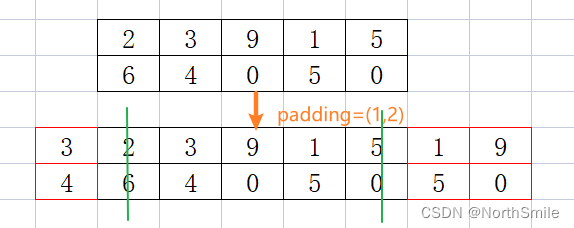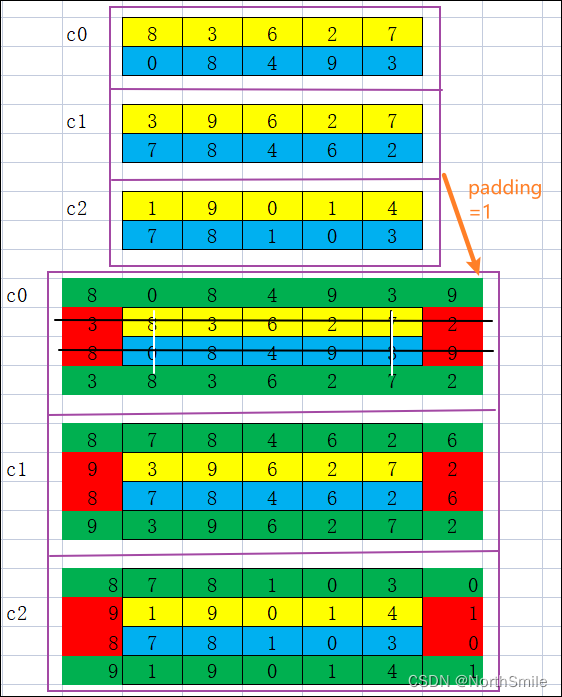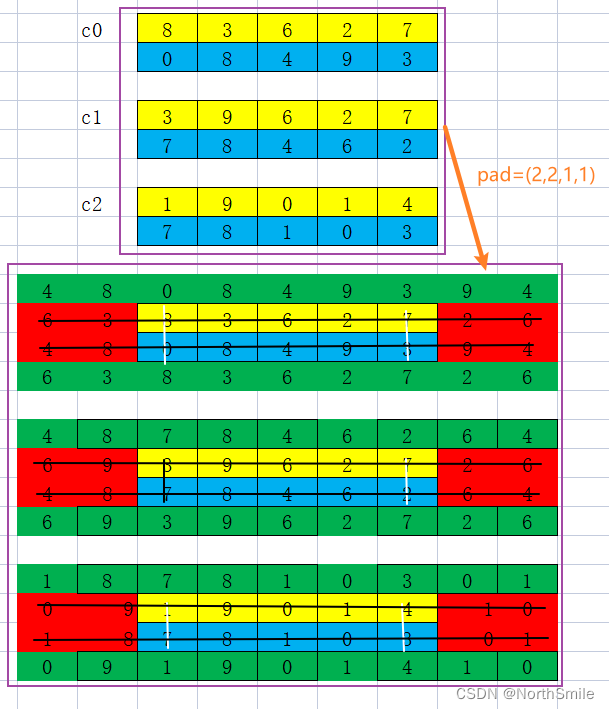反射填充详解ReflectionPad2d(padding)
ReflectionPad
- 一、反射填充
-
- 1、一维反射填充
-
- 1)调用方式
- 2)实例
-
- (1)padding为整数
- (2)padding为2元组
- 2、二维反射填充
-
- 1)调用方式
- 2)实例
-
- (1)padding为整数
- (1)padding为4元组
一、反射填充
这种填充方式是以输入向量的边界为对称轴,以设定的padding大小为步长,将输入向量的边界内padding大小的元素,对称填充。设定padding时主要注意,padding必须小于向量所在维度的大小。
1、一维反射填充
1)调用方式
- 输入形状为(N,C,W_IN)或(C,W_IN);
- 输出形状为(N,C,W_out)或(C,W_out);

- padding表示填充尺寸,可为整数或者2元组;padding为整数时,输入向量左右填充相同的大小;而padding为元组时可自定义向量左右分别填充多少;
torch.nn.ReflectionPad1d(padding)
2)实例
对于一维填充来说,其输入为N个宽度为W的向量,而每个元素对应有C个通道。此方式填充只针对他的宽度进行,填充点分别为向量左边和右边两个边界。不同的padding类型(整数或元组),决定了左右两边如何填充的方式。
(1)padding为整数
inp=torch.tensor([[[2., 3., 9., 1., 5.],
[6., 4., 0., 5., 0.]]])
print(inp.shape)
print("inp:",inp)
pad=1
out=nn.ReflectionPad1d(padding=pad)(inp)
print("padding={},out:".format(pad),out)
print(out.shape)
结果分析(绿线代表以此为轴,红色代表填充的元素):
1)当padding=1时,表示向量左右两边均以边界为对称轴,填充宽度为1的元素。
torch.Size([1, 2, 5])
inp: tensor([[[2., 3., 9., 1., 5.],
[6., 4., 0., 5., 0.]]])
padding=1,out: tensor([[[3., 2., 3., 9., 1., 5., 1.],
[4., 6., 4., 0., 5., 0., 5.]]])
torch.Size([1, 2, 7])

2)当padding=2时,表示向量左右两边均以边界为对称轴,填充宽度为2的元素。
torch.Size([1, 2, 5])
inp: tensor([[[2., 3., 9., 1., 5.],
[6., 4., 0., 5., 0.]]])
padding=2,out: tensor([[[9., 3., 2., 3., 9., 1., 5., 1., 9.],
[0., 4., 6., 4., 0., 5., 0., 5., 0.]]])
torch.Size([1, 2, 9])
(2)padding为2元组
inp=torch.tensor([[[2., 3., 9., 1., 5.],
[6., 4., 0., 5., 0.]]])
print(inp.shape)
print("inp:",inp)
pad=(1,2)
out=nn.ReflectionPad1d(padding=pad)(inp)
print("padding={},out:".format(pad),out)
print(out.shape)
结果分析:
1)当padding=(1,2)时,表示向量以边界为对称轴,左右两边分别填充宽度为1、2的元素。
torch.Size([1, 2, 5])
inp: tensor([[[2., 3., 9., 1., 5.],
[6., 4., 0., 5., 0.]]])
padding=(1, 2),out: tensor([[[3., 2., 3., 9., 1., 5., 1., 9.],
[4., 6., 4., 0., 5., 0., 5., 0.]]])
torch.Size([1, 2, 8])
2、二维反射填充
1)调用方式
- 输入形状为(N,C,H_in,W_IN)或(C,H_in,W_IN);
- 输出形状为(N,C,H_out,W_out)或(C,H_out,W_out);

- padding表示填充尺寸,可为整数或者4元组;padding为整数时,输入向量左右上下填充相同的大小;而padding为元组时可自定义向量左右上下分别填充多少;
torch.nn.ReflectionPad2d(padding)
2)实例
对于二维填充来说,其输入为N个宽度为H*W的数组,而每个元素对应有C个通道。此方式填充针对他的高度和宽度进行,填充点分别为上、下、左、右四个边界。不同的padding类型(整数或元组),决定了四个边界如何填充的方式。
(1)padding为整数
inp=torch.tensor([[[[8., 3., 6., 2., 7.],
[0., 8., 4., 9., 3.]],
[[3., 9., 6., 2., 7.],
[7., 8., 4., 6., 2.]],
[[1., 9., 0., 1., 4.],
[7., 8., 1., 0., 3.]]]])
print(inp.shape)
print("inp:",inp)
pad=1
out=nn.ReflectionPad2d(padding=pad)(inp)
print("padding={},out:".format(pad),out)
print(out.shape)
结果分析(图中白线、黑线代表以此为轴,红色、绿色块代表填充元素):
1)当padding=1时,表示向量以边界为对称轴,左、右、上、下四个边界均填充宽度为1的元素。
填充按照左、右、上、下的顺序依次填充。
padding=1,out: tensor([[[[8., 0., 8., 4., 9., 3., 9.],
[3., 8., 3., 6., 2., 7., 2.],
[8., 0., 8., 4., 9., 3., 9.],
[3., 8., 3., 6., 2., 7., 2.]],
[[8., 7., 8., 4., 6., 2., 6.],
[9., 3., 9., 6., 2., 7., 2.],
[8., 7., 8., 4., 6., 2., 6.],
[9., 3., 9., 6., 2., 7., 2.]],
[[8., 7., 8., 1., 0., 3., 0.],
[9., 1., 9., 0., 1., 4., 1.],
[8., 7., 8., 1., 0., 3., 0.],
[9., 1., 9., 0., 1., 4., 1.]]]])
torch.Size([1, 3, 4, 7])
(1)padding为4元组
inp=torch.tensor([[[[8., 3., 6., 2., 7.],
[0., 8., 4., 9., 3.]],
[[3., 9., 6., 2., 7.],
[7., 8., 4., 6., 2.]],
[[1., 9., 0., 1., 4.],
[7., 8., 1., 0., 3.]]]])
pad=(2,2,1,1)
out=nn.ReflectionPad2d(padding=pad)(inp)
print("padding={},out:".format(pad),out)
print(out.shape)
结果分析:
1)当padding=(2,2,1,1)时,表示向量以左、右、上、下边界为对称轴,左、右、上、下分别填充宽度为2,2,1,1的元素。
padding=(2, 2, 1, 1),out: tensor([[[[4., 8., 0., 8., 4., 9., 3., 9., 4.],
[6., 3., 8., 3., 6., 2., 7., 2., 6.],
[4., 8., 0., 8., 4., 9., 3., 9., 4.],
[6., 3., 8., 3., 6., 2., 7., 2., 6.]],
[[4., 8., 7., 8., 4., 6., 2., 6., 4.],
[6., 9., 3., 9., 6., 2., 7., 2., 6.],
[4., 8., 7., 8., 4., 6., 2., 6., 4.],
[6., 9., 3., 9., 6., 2., 7., 2., 6.]],
[[1., 8., 7., 8., 1., 0., 3., 0., 1.],
[0., 9., 1., 9., 0., 1., 4., 1., 0.],
[1., 8., 7., 8., 1., 0., 3., 0., 1.],
[0., 9., 1., 9., 0., 1., 4., 1., 0.]]]])
torch.Size([1, 3, 4, 9])



